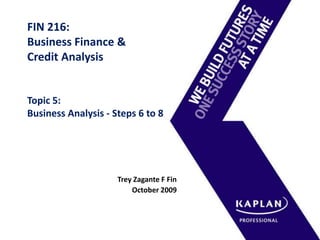
Business Finance & Credit Analysis
- 1. FIN 216:Business Finance & Credit AnalysisTopic 5: Business Analysis - Steps 6 to 8 Trey Zagante F Fin October 2009
- 5. Financial Data Classifications Information on financial statements fall under 5 classifications: Assets Liabilities Owners Equity Revenue Expenses
- 6. Cash Basis vs. Accrual Basis Cash Basis: Revenues recorded when received Expenses recorded when paid Accrual Basis: Revenues are recorded as they are earned Expenses are recorded as they are incurred Matching principle determines the accounting period when revenues and expenses are recognised
- 7. Balance Sheet Financial position of a business at a point in time Assets Liabilities Owners Equity Balance sheet equation: Assets = Liabilities + Owners Equity Current vs. non-current: Current < 12 months Non-current > 12 months Considerations: Liquidity Valuations
- 9. Owners Equity The financial interest that an owner (or owners) has in a business, also known as capital, net worth or proprietorship. Shareholders capital: Issued and paid up capital Different share types (ordinary/preference shares) Retained profit Reserves Dividends
- 10. Income Statement Financial performance of a business over a period of time Income statement equation: Profit (Loss) = Revenue - Expenses Revenue – The inflow of funds from the sale of goods and services Expenses – The costs incurred in operating the business Operating revenues: Divisions of the business Product lines Geographical
- 11. Income Statement cont’d Significant items Extraordinary items: Not part of normal operations e.g. divestment Measures of profit: Gross profit Net profit before income tax Net profit after tax (NPAT) Earnings before interest and tax (EBIT) Earnings before interest, tax, depreciation and amortisation (EBITDA)
- 12. Statement of Cash Flows The flow of cash in and out of a business over a period of time Operating activities: Day to day operations of the business Investing activities: Investment into the future of the business Financing activities: How the business finances its operations Change in cash over the period: Cash at the end of the period will match the cash position on the balance sheet
- 13. Analysis of Cash Flows Positive cash flows available for future expansion Liquidity of the business How does the business meet its financial obligations? Trends or patterns of cash flows The need for future debt or reliance on debt Free cash flows: Gross cash flow from operations less Capex
- 14. Step 7 – Financial Forecasts A key part of effective management of a business is having forecasts and projections. Projected figures may be generated by different sources Forecasts are based on assumptions and variables which must be stated The term of the funding should be covered by the forecasts Best case, worst case and most likely scenarios 3 to 5 years of historical data should be basis of forecasts
- 15. Sensitivity Analysis How sensitive is the business to changes in the variables of the forecasts? Key variables: Sales growth Profit margins Operating expenses Inventory control Investment into fixed assets Sensitivity to macroeconomic factors e.g. Global Financial Crisis Determine upper and lower limits of repayment capacity
- 16. Step 8 – Financial Ratio Analysis Analyse financial ratios extracted from the data in the financial statements. Comparative analysis of the business’ ratio’s against: Intra-entity Intra/inter-industry Accepted standards Benefits of financial ratio analysis: Determines strength of the business (capital structure, liquidity etc.) Limitations of financial ratio analysis: Doesn’t give the full picture of position/performance of a business Doesn’t take into account other factors Large variations of ratios even within a particular industry
- 17. Financial Ratio Analysis cont’d Commonly used ratios in business and credit analysis: Liquidity (current and acid test ratios) Capital structure (net debt/equity ratio) Debt protection (net interest cover) Profitability (EBIT margin) Time series analysis: Analyse a business’ ratio trends over time 3 to 5 year minimum trend analysis Good prediction of future trends Industry averages for financial ratios: Industry data is useful for benchmarking Data is available from various sources e.g. D&B, accounting firms
- 18. Other Considerations in Business Analysis Understand the business and the context of the environment in which it operates. Use qualitative and quantitative analysis SWOT Analysis of the business PESTLE Analysis Consider management capability: Particularly relevant for SME’s and start ups Experience and capacity of key management Consider business risks: Use other risk models Porter’s Five Forces
- 19. Porter’s Five Forces Model
